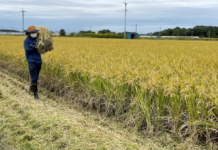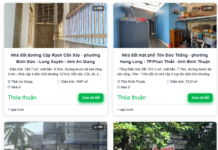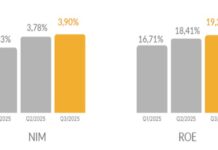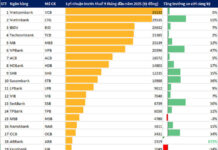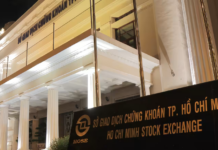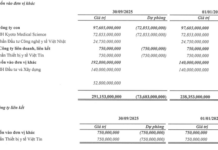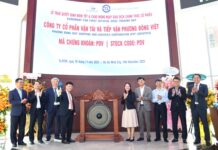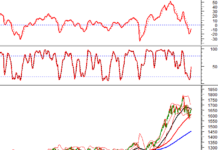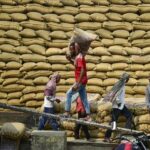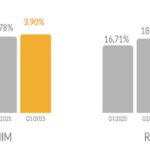Just two years ago, Vietnam’s coffee export value hovered around $3 billion annually. Fast forward to 2024, and coffee exports have surged past $5 billion, with projections reaching $9 billion this year.
Consistently Sold Out
Mr. Nguyễn Đức Hưng, Director of Napoli Coffee Production, Trade, and Export JSC, notes that in recent years, every international trade fair has highlighted the strong appeal of Vietnamese coffee. “We bring as much coffee as possible, and it’s always sold out—not just for our brand, but for almost every company,” shares Mr. Hưng.
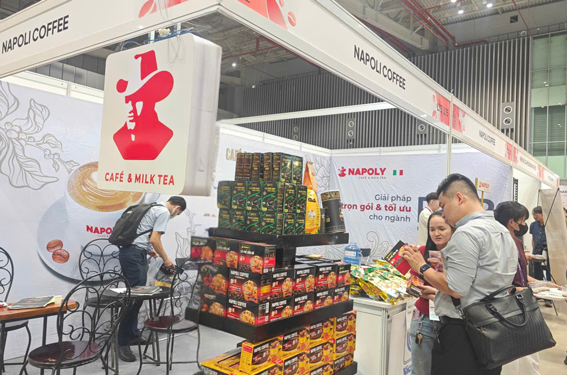
Napoli Coffee at an international trade fair in Ho Chi Minh City
Growing global interest not only opens opportunities for the coffee industry but also boosts related sectors like logistics and supporting industries, while enhancing Vietnam’s global image.
According to Mr. Hưng, the U.S. imposing high tariffs on Brazilian coffee (50%, potentially dropping to 40%) creates a “gap” for Vietnamese coffee. With competitive pricing and improving quality, Vietnamese businesses have a chance to expand their market share in the U.S.
Napoli currently exports coffee to over 20 countries, offering products like cold-brew, spray-dried, phin coffee, roasted beans, paper bag coffee, decaffeinated coffee, and “3-in-1” instant coffee.
For large retail systems, production is tailored to client requests; for distributors, products are exported under the Napoli brand. “Increasing the share of processed coffee will significantly boost Vietnam’s coffee value and attract more international tourists,” Mr. Hưng predicts.
As a coffee tasting and specialty roasting expert, Mr. Nguyễn Tấn Vinh, Director of K-Pan Co., Ltd. and a Master Roaster of Fine Robusta, observes that “Vietnamese coffee is trending globally.” He notes that international coffee fairs and exhibitions in Vietnam consistently draw large foreign audiences, with most participating companies, even small ones, securing export deals. “Vietnamese coffee experts and businesses are frequently invited as speakers at major global coffee events,” Mr. Vinh adds.
He himself has received invitations from partners in Japan and South Korea, where Vietnamese iced coffee, milk coffee, and specialty Robusta are highly sought after. “In South Korea and Japan, many cafes proudly display ‘Vietnamese Coffee’ signs, often paired with Vietnamese bánh mì,” Mr. Vinh mentions.
Meanwhile, Mr. Nguyễn Tuấn Dũng, Director of iForest Co., Ltd. (Đắk Lắk), shares that two Turkish partners—a roaster and a café owner—previously used expensive Arabica from Colombia and Ethiopia. After discovering Vietnam’s high-quality Robusta at a much lower price, they scored it 81-82/100 and decided to purchase it at $10.70/kg, double the price of regular coffee.
Mr. Dũng notes that many international buyers now visit Vietnam directly to source products, rather than relying solely on importers. This presents a prime opportunity for startups lacking resources for overseas marketing.
Maintaining High Prices
Global demand has kept Vietnamese coffee prices consistently high. Robusta prices on the London exchange have fluctuated between $3,200 and $5,800/ton this year. However, the Ministry of Agriculture and Rural Development reports that Vietnam’s average export price (including processed coffee) reached $5,653/ton in the first 10 months, up 42% year-on-year. During this period, Vietnam exported over 1.3 million tons of coffee, earning $7.41 billion—a 13.5% volume increase and a 61.8% value surge. This highlights Vietnam’s strong market appeal and premium pricing.
The Import-Export Department (Ministry of Industry and Trade) reports stable exports to the EU and U.S. in 2025, solidifying Vietnam’s global coffee position. Processed coffee exports reached $1.18 billion by August 2025, up 63.5% year-on-year, outpacing overall industry growth.
This marks a significant shift toward value-added exports over raw beans. However, the department warns that maintaining competitiveness requires addressing challenges in processing capacity, quality standardization, and national branding.
Mr. Đỗ Hà Nam, Chairman of Intimex Group and Vice Chairman of the Vietnam Coffee-Cocoa Association (VICOFA), notes that Vietnamese Robusta prices once peaked globally, even surpassing Arabica. Major roasters still rely on Vietnamese Robusta for its unique flavor. For instance, Japan’s second-largest coffee brand (after Starbucks) uses Vietnamese coffee, reflecting growing global preference.
To further enhance value, Mr. Nam stresses the need for deep processing and robust branding, as “product value is recognized only when consumers accept it.”
With the industry’s bright outlook, Mr. Nguyễn Tiến Định, Director of VCU JSC, aims to export 1,000 tons of roasted coffee beans in 2026, up from 300 tons this year, despite being a startup.
Exporting roasted beans offers higher margins but requires complex techniques. Securing orders demands repeated flavor adjustments to meet client expectations.
Most international buyers prefer green beans for local roasting to maximize profits. Mr. Định suggests Vietnamese firms target partners lacking roasting capabilities, offering comprehensive services from production to quality control, allowing them to focus on distribution.
Urgent Need for Branding
Vietnam exports about 1.5 million tons of Robusta annually, accounting for 43% of global exports and ranking first in this segment. However, Vietnam lacks an official “national brand” for its Robusta—no standardized cupping profile, unified marketing strategy, or proper global positioning.
VICOFA is collaborating with domestic and international organizations to establish a brand for Vietnamese Robusta, particularly specialty varieties.
Asian Rice Export Prices Under Pressure as Weak Demand Meets Rising Supply
Export rice prices from India and Vietnam remained stable this week, while Thai rice prices experienced a slight decline due to reduced demand and ample supply.




